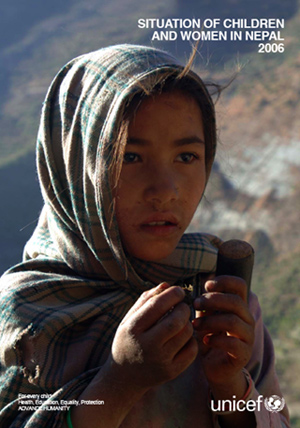
|
| Reports on Nepal's Civil War: Landmines |
|
|
|
|
|
| Educating Nepalese youths about the dangers of explosives |
Kathmandu,
Nepal, 11 October 2007
By
Rupa Joshi
 |
|
"This is a totally different kind of experience," said Lieutenant-Colonel Khadka, for whom teaching a group of young students was a unique undertaking.
As part of the 'Don't Touch Explosive Devices - Save Lives, Save Limbs' campaign, Lieutenant-Colonel Khadka familiarized those present with how to identify IEDs, explaining that the devices are often simply made from household items such as pressure cookers, pipes and sockets.
"If you see any objects that look like these or if you see things where they should not normally be, don't touch them," he warned the children. "Go and tell your teacher or the elders at home or in the village, and ask them to get in touch with the authorities."
The campaign, which encourages civilians to report the location of dangerous explosive devices all across the country through a telephone hotline, was initiated by the UNICEF-supported Mine Action Group.
Students sit with one of the mine risk awareness posters being distributed as part of a local campaign.
Using every opportunity
 |
|
| Mine awareness campaign aims to save lives and limbs in Nepal |
KAVRE,
Nepal, 13 April 2007
By
Robin Giri
 |
|
"This is the spot where Suraj kicked that metallic object," says Sunil, 11, tapping the ground with his cane. Led by his dad, he taps the ground again, trying to show the spot where the explosive device was buried.
Sunil was blinded in both eyes by the explosion. His friend Sanjay had severe burns to his face. Sadly, their friend Suraj, was instantly killed by the impact.
'Save Lives, Save Limbs' campaign
Although the conflict in Nepal officially ended in April 2006, improvised explosive devices, unexploded ordnance and landmines used during the country's decade-long conflict continue to take the lives and limbs of Nepalis - most of them children like young Suraj.
In the first quarter of 2007 alone, 45 people - including 27 children - have fallen prey to deadly explosions. Between 2004 and 2006, some 425 civilian casualties were reported, more than half of them children. This brought Nepal on par with countries such as Laos, with one of the highest rates of child casualties from mine-related explosions.
As part of a broader campaign to protect children, on 2 February the Mine Action Group of Nepal launched the 'Don't Touch Explosive Devices - Save Lives, Save Limbs' campaign. Initiated by UNICEF in 2004, the Mine Action Group involves many international, national and local partners, all working to create awareness on the danger of mines and minimize the loss of limbs and lives to children and families.
Print, radio and TV messages
The campaign, which incorporates print, radio and television messages, has been launched at the district and village level to teach children and adults how to identify the different types of threats.
Villagers are also encouraged to report any explosive devices to a telephone hotline. This information is to be passed on to relevant authorities who will conduct defusing activities to clear areas where devices are found.
Along with the massive print media campaign, audio and video clips portraying the most likely scenarios for the accidental detonation of explosive devices are being aired nationwide as well.
Mine Ban Treaty advocacy
The Mine Action Group is also urging the government to sign and ratify the Ottawa Convention, also known as the Mine Ban Treaty, as the government is not yet a signatory to this international agreement.
"This campaigns seeks to warn the general public, and more so children, who are by nature more mobile and inquisitive, to be aware of the dangers," says UNICEF Representative in Nepal Gillian Mellsop.
"Mine Action in Nepal is still in its infancy," continues Ms. Mellsop. "We still have not been able to reach all the at-risk villages with our mine risk education activities. De-mining is yet to pick up speed and we are working on establishing partnerships with different stakeholders in order to provide assistance to those that have been injured."
| External link |
| UNICEF |
|

|
